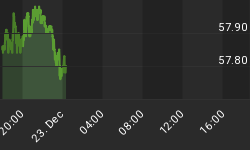Good News Is Finally Good News

Earlier this week, we covered the good news is bad news logic that dominated the markets Monday through Thursday. Friday, the markets shifted to a "good payroll numbers mean a strengthening economy, which is good news for stocks" stance. From Bloomberg:
U.S. stocks advanced, halting a five-day slide for the Standard & Poor's 500 Index, as investors weighed better-than-forecast jobs growth to gauge the strength of the economy and timing of Federal Reserve stimulus cuts. "It appears that the market is getting increasingly comfortable with a taper scenario that parallels an incrementally stronger economy," Jim Russell, who helps oversee $112 billion as a senior equity strategist for U.S. Bank Wealth Management, said by phone. "The higher number could more easily be accepted because the market had traded down, anticipating what was likely to be a stronger number today, and of course we got that."
Markets Held At Logical Support Thursday
While there is no question the bulls were struggling heading into Friday's labor report, there was some reason for patience and hope. Support levels are monitored by money managers since they represent areas where buyers may become interested again. Is technical analysis helpful? It was Thursday in terms of saying "exercise some patience with stocks".


Wonder Twin Powers Activate
PIMCO, a large bond shop, pointed out a relevant synergy that could help housing and the stock market.

You may ask, where do they get "dovish Fed" after the better than expected labor report? Chicago Fed President Charles Evans sent up some "we may need to see more" flares Friday. From Reuters:
A top Federal Reserve official said on Friday he was "open-minded" to the idea of reducing the U.S. central bank's bond purchasing stimulus program this month, but he would like to see a stronger labor market first. "I'll be open-minded," Evans said in an interview with Reuters Insider. "Everything else (being) equal I would like to see a couple of months of good numbers, but this was improvement." Evans is a voting member on the Fed's policy-setting committee this year and has been an outspoken advocate for the institution's efforts to nurse the economy back to health following the 2007-09 recession.
Investment Implications

The bulls salvaged the week with a favorable session Friday. The S&P 500 dropped less than 1 point over the last five sessions, which could help the bulls since it eliminates the potentially bearish "how many consecutive weeks can stocks rise?" argument. A nearly flat S&P 500 this week says not much changed in the battle between bullish economic conviction and bearish economic conviction; the bulls still have the upper hand. Consequently, we will continue to hold our long positions in U.S. stocks (SPY), technology (QQQ), financials (XLF), energy (XLE), small caps (IWM), foreign stocks (EFA), and emerging markets (EEM).
Allocation Shift
We cut back on our exposure to foreign stocks Thursday; those funds were redeployed Friday in U.S. equities (SPY) per our market model rules. The S&P 500 has gained 159 points since the Oct 9 intraday low. The market model called for redeployment of cash beginning on October 10. The model has remained long, with no shorts, hedging, or bonds for eight weeks. Once volatility reaches levels that "we cannot ignore", the model will call for an incremental reduction in equity exposure. Thus far, we have experienced "volatility to ignore". We will enter next week with an open and flexible mind.
Weekend Reading

As the markets have continued to march higher, you may have had some of the questions below cross your mind, especially if you are a longer-term investor rather than a trader. There are always things to be concerned about, but some of the topics below are often mislabeled as rally killers:
- Are we in a "everybody is in euphoric stock bubble?"
- How likely is a 2008-like stock market crash?
- Shouldn't we be concerned about all the bubble talk in the media?
- How do we account for possible Fed-related risk?
















